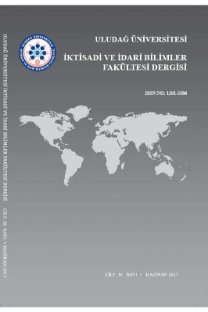Kentte işlenen işyeri suçları: Bursa ili örneği
___
Ackerman, V.W., (1998), “Socioeconomic Correlates of Increasing Crime Rates in Smaller Communities”, Professional Geographer, 50 (3), 372-387.Andersan, A.M., (2005), “Crime Measures and The Spatial Analysis of Criminal Activity”, British Journal of Criminology, 46, 258-285.
Ayhan İ., Çubukçu K.M., (2007), “Suç ve Kent İlişkisine Ampirik Bakış: Literatür Taraması”, Süleyman Demirel Üniversitesi Sosyal Bilimler Enstitüsü Dergisi, 3(5), 30-55.
Aytaç Mustafa, Aytaç Serpil, Bayram Nuran, (2007), “Suç Türlerini Etkileyen Faktörlerin İstatistiksel Analizi”, 8. Türkiye Ekonometri ve İstatistik Kongresi, 24-25 Mayıs, İnönü Üniversitesi, Malatya.
Balcıoğlu İbrahim, (2001), Şiddet ve Toplum, Bilge Yayınları, İstanbul.
Black Donald, (1976), The Behavior of Law, New York: Academic Press.
Bozkurt Veysel, (2004), Değişen Dünyada Sosyoloji, Alfa Yayınları, Bursa.
Ceccato V., Haining R., Signoretta P., (2002), “Exploring Offence Statistics in Stockholm City Using Spatial Analysis Tools”, Annals of The Association of American Geographers, 92(1), 29-51.
Cozens P. M., (2002), “Sustainable Urban Development and Crime Prevention Through Environmental Design for the British City”, Towards an Effective Urban Environmentalism for the 21st Century Cities, 19, 2, 129-137.
Demirbaş. Timur, (2001), Kriminoloji, Seçkin, Ankara, 2001.
Dönmezer Sulhi, (1994), Kriminoloji, Gözden Geçirilmiş 8. Bası, Beta Basım Yayım Dağıtım A.Ş., İstanbul.
Durkheim Emile, (1985), Toplumbilimsel Yöntemin Kuralları, C. B. Akal (Çev), B/F/S Yayınları, İstanbul.
Ergun N., Yirmibeşoğlu F., (2005), “İstanbul’da 2000-2004 Yılları Arasında Suçun Mekansal Dağılımı”, 8 Kasım Dünya Şehircilik Günü 29. Kolokyumu “Planlamada Yeni Politika ve Stratejiler Riskler ve Fırsatlar, İstanbul, 2005, 295-307.
Farrington David P., (1986), “Age and crime”, Tonry, M. & Morris, N. (Eds) Crime and justice: An annual review of research, Vol 7, 189-250.
Farrington David P.,(2003), “Developmental and life-course criminology: Key theoretical and empirical issues—the 2002 Sutherland Award Address”, Criminology, 41, 221–255.
Gizewski P., Homer-Dixon T., (1995), “Urban Growth and Violence: Will the Future Resemble the Past?”, EPS, June 1995.
Greenberg David F., (1985), “Age, Crime, and Social Explanation”, The American Journal of Sociology, Vol.91, No.1, 1-21.
Gruenewald P. J., Freisthler B., Remer L., LaScala E. A., Treno A., (2006), “Ecological Models of Alcohol Outlets and Violent Assaults: Crime Potentials and Geospatial Analysis”, Addiction, 101, 666-677.
Hogset III, Randall M. ve Radig, William J., (1994),” Employee Crime: The Cost and Some Control Measures”, Review of Business, Vol. 16, Issue 2.
http://www.kriminoloji.com/Krminolojide20Suc.htm, Erişim Tarihi: 02.05.2005.
İçli Tülin Günşen, (2004), Kriminoloji, Martı Kitap ve Yayınevi, Ankara.
Krueger B. Alan, Pischke Jorn-Steffen, (1997), “A Statistical Analysis of Crime Aganist Foreigners in Unified Germany”, Journal of Human Resources, Vol.32, No.1, 182-209.
Lay M. C. D., Reis A., Ambrosini V., (2005), “Spatial Configuration, Spatial Behaviour and Spatial Cognition:Syntactic and Perceptual Analysys of The Market Station Area in Porto Alegre”, Proceedings of EDRA 36, Design for Diversity Conference, Vancouver, 2005, Kanada, 129-135.
Martinez Michelle Neely, (1995), “Studies on Workplace Crime Question Business Ethics”, HR Magazine, Vol.40.
McVie S., (2005), Patterns of Deviance Underlying The Age-Crime Curve: The Long Term Evidence
Newman O., (1972), Defensible Space: Crime Prevention Through Urban Design, New York, Macmillan.
Rycus M.J., (1998), “Can Sound Urban Planning Help Reduce Urban Crime and Violence”, Habitat Debate, UNCHS, Vol. 4, No. 1.
Sarasalo Elina, Bergman Bo & Toth Janos, (1997), “Theft behaviour and its consequences among cleptomaniacs and shoplifters a comparative study”, Forensic Science International, Vol. 86, Issue 3, 193-200.
Schuerman L.; Kobrin S., (1987), Communities and Crime, ed: Reiss A.J.Jr. and Tony M., The University of Chicago Press, Chicago.
Sezal İhsan, (2003), Sosyolojiye Giriş, Ankara: Martı Yayınları.
Sherman L. W., (1995), “Hot spots of crime and criminal careers of places”, J. E. Eck & D. Weisburd (eds.), Crime and place, Crime Prevention Studies, Vol. 4, 35–52, Monsey, NY: Criminal Justice Press.
Smith D.J., McVie S., (2003), “Theory and method in the Edinburgh Study of Youth Transitions and Crime”, British Journal of Criminology, 43, 169-195.
Steffensmeier Darrell, Allan Emilie, “Gender and Crime - Similarities In Male And Female Offending Rates And Patterns, Differences Between Male And Female Offending Patterns”, http://law.jrank.org/pages/1256/Gender- Crime.html.
Tozar Z., (2001), “Çağın Terör Olayının Ardından Suç Beyinde mi?”, Bilim Teknik, sayfa 48-53.
Wang F., Minor W. W., (2002), Where The Jobs Are: Employment Access and Crime Patterns in Cleveland, Annals of the Association of American Geographers, 92(3), 435-450.
www.britsoccrim.org/volume7/007.pdf
www.sociology.org.uk/pblsdca.pdf
www.yerelnet.org.tr/uluslararası/ avrupakonseyianlaşma7.php
- ISSN: 1301-3386
- Yayın Aralığı: Yılda 2 Sayı
- Başlangıç: 2018
Kentte işlenen işyeri suçları: Bursa ili örneği
SELVER YILDIZ BAĞDOĞAN, Neslihan SAM, NURAN BAYRAM ARLI
Türkiye’de marksist sol popülizm-milliyetçilik
Hisse senedi ve döviz piyasası risklerinin riske maruz değer yöntemi ile karşılaştırılması
Tam zamanında üretim ve toplam kalite yönetimi ayrımının diskriminant analizi ile incelenmesi
